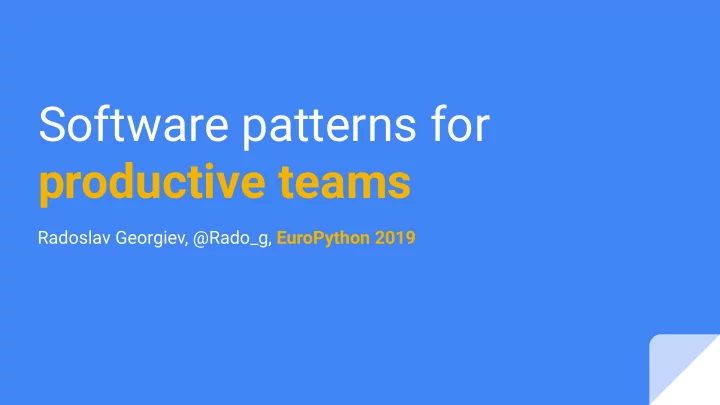

Software patterns for productive teams Radoslav Georgiev, @Rado_g, EuroPython 2019
3rd EuroPython for me ✔
Goal of this talk: Be practical , pragmatic & provide value .
Goal of this talk: “Aha! We should try this” moment.
Context : I’m CEO of HackSoft - a software development company .
I’ll provide cherry-picked examples on the topic from our experience.
Agenda 1. Team leader’s perspective. 2. Software development. 3. Features. 4. Explicit is better than implicit.
Team leader’s perspective. What I care for, when I’m a team lead.
Team leader’s perspective 1. Productivity (we need to ship features) 2. Confidence (we need to keep the product stable) 3. Independence (make their own decisions) 4. Well-being / stress of team members (burnout is bad) 5. Less context switching for everyone (don’t break the flow) 6. Someone being blocked by something (feeling unproductive) 7. Morale (overall feeling)
Constant regressions .
Constant regressions Problems: Possible solutions: Production is constantly broken / Stop all feature development until ● ● something’s not working. software is stable again. ● Quick “proof of concept” is being turned ● Add CI & run tests / lints if you don’t have into production-ready version. one. Can decrease team morale. Add a staging environment & don’t test on ● ● production.
Constant merge conflicts .
Constant merge conflicts
Constant merge conflicts
Constant merge conflicts ● Split python modules by domain. Split big test files into test file per thing that you are testing. ● ● Constantly watch for merge conflicts - this means something’s not right.
Constant merge conflicts
Local setup . A specific type of hell.
Local setup - accounts ● Devs can’t even start working on a feature if they can’t get something running locally. Make sure everyone has an account / access / keys for everything needed. ● Do that before they need it. Keep a spreadsheet of accounts & 3rd parties. Easier to track & manage. ●
Local setup - accounts
Local setup - documentation ● Relentlessly document everything related to local setup. Test it and keep it updated. ● ● GitHub / Confluence / whatever is working for you . Onboarding new people is your final test. ●
Local setup - setup scripts ./setup/bootstrap.sh # get a clean & ready to go local dev environment ./setup/xero.sh # Setup additional 3rd party ./setup/gocardless.sh # Setup additional 3rd party ./setup/everything.sh # Setup all 3rd parties in a clean local dev environment
Speed of tests. Very important & often overlooked.
Speed of tests ● If you are working in an environment with small PRs, merge often & deploy often ... … and your tests are taking 10 minutes to run on CI ... ● ● …. you are not going to feel very productive & you’ll often find yourself waiting or CI.
pytest-xdist / py.test -x -n 4
Optimize your tests. It pays off!
Features Make sure everyone are on the same page with this.
Feature descriptions ● If the features are described poorly, people are going to build the wrong thing. Clients often don’t know the exact details of the things they want , so ask ● them a lot of questions! Make sure everyone on your team actually reads the feature descriptions ● fully, before starting to work.
Feature blocking
Feature blocking ● Pair people around shared parts , so they are on the same page. Identify such scenarios quickly & resolve them. Otherwise work is going ● to be deleted / undone. ● Such scenarios may cause conflicts.
Explicit is better than implicit.
There’s a bug!
There’s a bug! ● Have an explicit “firefighter” for the week. Rotate everyone on that position , each week. ● ● This “firefighter” is the first responder when there’s an issue. A lot of the issues can be resolved quickly, without sacrificing all of the team’s attention.
Explicit Git & GitHub workflows. No matter what you use.
Refactoring PRs separated from feature PRs . Easier to read, easier to catch problems.
Team rules.
Team rules ● Write down everything from “This is how we do things here” . Better visibility at team dynamics & explicit expectations from everyone. ● ● A great tool for onboarding new people. Revisit & update! ●
Have an explicit team lead. Otherwise, there is going to be an implicit one.
Have an explicit team lead. ● Know who the leader is. That’s the person making the calls when needed & the person who’s responsible for the team success. Team leads should focus on enabling their teams do their job well. If this ● means less coding - then so be it. We rotate team leads every week , so everyone knows what it’s like to be ● on that position. Gives perspective.
Conflicts. You cannot avoid them, but you have to handle them.
Conflicts ● Catch early & try to overcommunicate with all parties involved. Read books on management & leadership. Use your gut feeling. ● ● Have perspective on what’s important. Beware of toxic people & malicious obedience. ● ● Fire , if necessary (easier said than done)
Adapt.
Adapt ● If something’s not currently working - understand why & make changes. Establish processes but don’t follow them blindly. ● ● Teams are different (people are different ). Things change. ●
Ask your developers for pain points . They will tell you. And do something about them.
Thank you. Questions? Radoslav Georgiev, CEO of HackSoft @Rado_g radorado@hacksoft.io
Recommend
More recommend